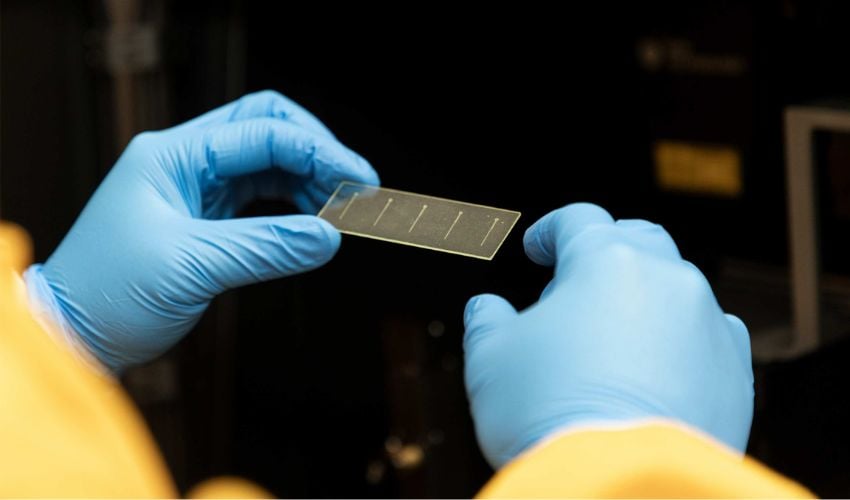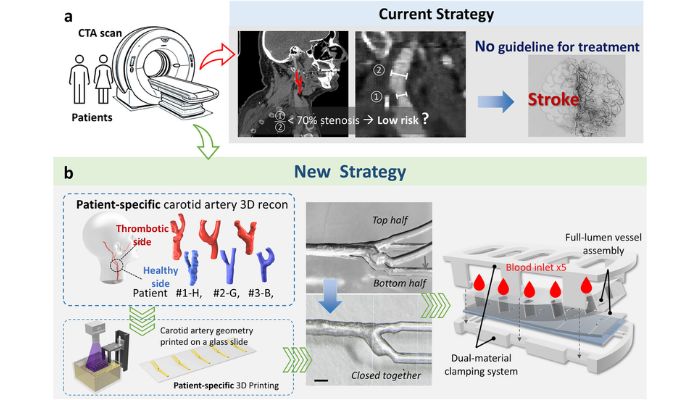How Researchers Are 3D Printing Blood Vessels to Understand Strokes

Imagine a future where a medical facility can take a patient’s CT scan, rapidly 3D print their blood vessel model, test how their blood responds, and even use AI to predict their risk of stroke years in advance. This is the kind of future proposed by a team of researchers at the University of Sydney, who recently designed a new technology for 3D printing blood vessels. Published in Advanced Materials, their approach allows the creation of vessels that closely replicate real anatomical structures as well as the complex fluid dynamics of blood flow. The goal is to provide a tool for studying what causes strokes and, possibly, to support the development and testing of patient-specific treatments.
This is not the first time researchers have 3D printed blood vessels, but part of what sets this project apart is the speed of the operation. By using CT scans of stroke patients, the researchers made miniature models, reducing the original carotid artery 3D model to 200 to 300 micrometers, compared to a full-sized carotid artery at 5 to 7 mm. Then, they printed these models on glass slides, creating accurate replicas of healthy and diseased areas of blood vessels. This included features commonly seen in stroke patients, like dents and divots on the damaged lining of the blood vessel wall. Thanks to the miniature nature of the model, these vessels could be printed in two hours, instead of ten.

A visualization of the current strategy used for assessing stroke risk, versus the new one proposed. (Image credit: Charles Zhao et al.)
“When it comes to heart attack and stroke diagnosis, speed and accuracy is key,” PhD candidate Charles Zhao from the School of Biomedical Engineering, Faculty of Engineering said. “Clinicians typically have an approximately 12-hour decision-making window after symptom onset.”
The Sydney researchers used digital light processing (DLP) 3D printing onto a glass substrate to create these vessels, which they called “patient-specific carotid artery-on-a-chip devices.” By using treated glass slides as printing substrates and custom-designed mechanical clamping, they achieved around a 100% success rate.
What Blood Vessel Models Reveal About Strokes
After the blood vessels were 3D printed, they looked like fine engravings on glass. But inside these delicate structures, researchers could see accurate blood flow simulations that generate similar fluid dynamics and movement of natural blood flow. According to the team, re-creating and being able to visualize these fluid dynamics was one of the biggest challenges of the field, so achieving this was significant.
In real time and under the microscope, the researchers were able to see blood clot formation and the behavior of platelets, which are a crucial component involved in blood clotting that could lead to a stroke. The technology revealed that the friction and force created by blood flow moving against the lining of the blood vessels greatly influenced platelet movement, which regulates clotting. This happens with high blood pressure and atherosclerosis, a disease of the arteries. The researchers discovered that there were 7 to 10 times more platelet movement in areas where there were high levels of stress placed on the blood vessels.

A detailed 3D reconstruction and fabrication of patient-specific carotid artery vessel geometries. (Image credit: Charles Zhao et al.)
With this “physical twin” of the patient’s blood vessels, the researchers aim to, in the future, make personalised vascular medicine. “Our next frontier is integrating artificial intelligence with our biofabrication platform to create true ‘digital twins’ that can predict stroke events before they happen, moving from reactive treatment to proactive prevention,” Helen Zhao, postdoctoral digital scientist and operations manager at the MBL, added. Ultimately, this biomanufacturing approach is a significant advance in patient-specific organ-on-a-chip technology. To learn more about the study, read it here.
What do you think of the 3D printed blood vessels for studying strokes? Let us know in a comment below or on our LinkedIn and Facebook pages. Plus, sign up for our free weekly Newsletter to get the latest 3D printing news straight to your inbox. You can also find all our videos on our YouTube channel. Interested in more medical and dental 3D printing news? Visit our dedicated page HERE.
*Cover Photo Credit: The University of Sydney








Wow, this is fascinating! 3D printing blood vessels based on CT scans is such a cool idea. I’m really intrigued by the potential for predicting stroke risk with AI. Imagine how many lives that could save!